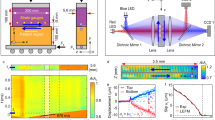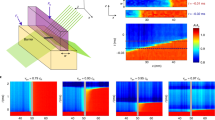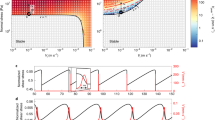Abstract
The dynamics of friction have been studied for hundreds of years, yet many aspects of these everyday processes are not understood. One such aspect is the onset of frictional motion (slip). First described more than 200 years ago as the transition from static to dynamic friction, the onset of slip is central to fields as diverse as physics1,2,3, tribology4,5, mechanics of earthquakes6,7,8,9,10,11 and fracture12,13,14. Here we show that the onset of frictional slip is governed by three different types of coherent crack-like fronts: these are observed by real-time visualization of the net contact area that forms the interface separating two blocks of like material. Two of these fronts, which propagate at subsonic and intersonic velocities, have been the subject of intensive recent interest12,13,14,15,16,17. We show that a third type of front, which propagates an order of magnitude more slowly, is the dominant mechanism for the rupture of the interface. No overall motion (sliding) of the blocks occurs until either of the slower two fronts traverses the entire interface.
This is a preview of subscription content, access via your institution
Access options
Subscribe to this journal
Receive 51 print issues and online access
$199.00 per year
only $3.90 per issue
Buy this article
- Purchase on Springer Link
- Instant access to full article PDF
Prices may be subject to local taxes which are calculated during checkout





Similar content being viewed by others
References
Ciliberto, S. & Laroche, C. Energy dissipation in solid friction. Eur. Phys. J. B 9, 551–558 (1999)
Muser, M. H., Wenning, L. & Robbins, M. O. Simple microscopic theory of Amontons's laws for static friction. Phys. Rev. Lett. 86, 1295–1298 (2001)
Baumberger, T., Berthoud, P. & Caroli, C. Physical analysis of the state- and rate-dependent friction law. II. Dynamic friction. Phys. Rev. B 60, 3928–3939 (1999)
Bowden, F. P. & Tabor, D. The Friction and Lubrication of Solids (Oxford Univ. Press, New York, 2001)
Persson, B. N. J. Sliding Friction Physical Principles and Applications (Springer, New York, 2000)
Heaton, T. H. Evidence for and implications of self-healing pulses of slip in earthquake rupture. Phys. Earth Planet. Inter. 64, 1–20 (1990)
Cochard, A. & Rice, J. R. Fault rupture between dissimilar materials: Ill-posedness, regularization, and slip-pulse response. J. Geophys. Res. B 105, 25891–25907 (2000)
Ben-Zion, Y. Dynamic ruptures in recent models of earthquake faults. J. Mech. Phys. Solids 49, 2209–2244 (2001)
Andrews, D. J. & BenZion, Y. Wrinkle-like slip pulse on a fault between different materials. J. Geophys. Res. B 102, 553–571 (1997)
Dieterich, J. H. & Kilgore, B. D. Direct observation of frictional contacts — new insights for state-dependent properties. Pure Appl. Geophys. 143, 283–302 (1994)
Rice, J. R., Lapusta, N. & Ranjith, K. Rate and state dependent friction and the stability of sliding between elastically deformable solids. J. Mech. Phys. Solids 49, 1865–1898 (2001)
Rosakis, A. J., Samudrala, O. & Coker, D. Cracks faster than the shear wave speed. Science 284, 1337–1340 (1999)
Xia, K., Rosakis, A. J. & Kanamori, H. Laboratory earthquakes: The sub-Raleigh-to-supershear rupture transition. Science 303, 1859–1861 (2004)
Gao, H. J., Huang, Y. G. & Abraham, F. F. Continuum and atomistic studies of intersonic crack propagation. J. Mech. Phys. Solids 49, 2113–2132 (2001)
Freund, L. B. The mechanics of dynamic shear crack propagation. J. Geophys. Res. 84, 2199–2209 (1979)
Scholz, C. H. Earthquakes and friction laws. Nature 391, 37–42 (1998)
Gerde, E. & Marder, M. Friction and fracture. Nature 413, 285–288 (2001)
Rice, J. R. & Ruina, A. L. Stability of steady frictional slipping. J. Appl. Mech. 50, 343–349 (1983)
Kilgore, B. D., Blanpied, M. L. & Dieterich, J. H. Velocity dependent friction of granite over a wide range of conditions. Geophys. Res. Lett. 20, 903–906 (1993)
Ben-Zion, Y. & Huang, Y. Q. Dynamic rupture on an interface between a compliant fault zone layer and a stiffer surrounding solid. J. Geophys. Res. B 107, doi:10.1029/2001JB000254 (2002)
Anooshehpoor, A. & Brune, J. N. Wrinkle-like Weertman pulse at the interface between two blocks of foam rubber with different velocities. Geophys. Res. Lett. 26, 2025–2028 (1999)
Bodin, P., Brown, S. & Matheson, D. Laboratory observations of fault-normal vibrations during stick slip. J. Geophys. Res. B 103, 29931–29944 (1998)
Andrews, D. J. Rupture velocity of plane strain shear cracks. J. Geophys. Res. B 81, 5679–5687 (1976)
Ohnaka, M. & Shen, L. F. Scaling of the shear rupture process from nucleation to dynamic propagation: Implications of geometric irregularity of the rupturing surfaces. J. Geophys. Res. B 104, 817–844 (1999)
Baumberger, T., Caroli, C. & Ronsin, O. Self-healing slip pulses and the friction of gelatin gels. Eur. Phys. J. E 11, 85–93 (2003)
Kanamori, H., Anderson, D. L. & Heaton, T. H. Frictional melting during the rupture of the 1994 Bolivian earthquake. Science 279, 839–842 (1998)
Bouchon, M. et al. How fast is rupture during an earthquake? New insights from the 1999 Turkey earthquakes. Geophys. Res. Lett. 28, 2723–2726 (2001)
Crescentini, L., Amoruso, A. & Scarpa, R. Constraints on slow earthquake dynamics from a swarm in central Italy. Science 286, 2132–2134 (1999)
Linde, A. T. & Sacks, I. S. Slow earthquakes and great earthquakes along the Nankai trough. Earth Planet. Sci. Lett. 203, 265–275 (2002)
Rogers, G. & Dragert, H. Episodic tremor and slip on the Cascadia subduction zone: The chatter of silent slip. Science 300, 1942–1943 (2003)
Acknowledgements
We thank Z. Reches, A. Sagy and M. Shay for comments. This research was supported by the Israel Science Foundation.
Author information
Authors and Affiliations
Corresponding author
Ethics declarations
Competing interests
The authors declare that they have no competing financial interests.
Rights and permissions
About this article
Cite this article
Rubinstein, S., Cohen, G. & Fineberg, J. Detachment fronts and the onset of dynamic friction. Nature 430, 1005–1009 (2004). https://doi.org/10.1038/nature02830
Received:
Accepted:
Issue Date:
DOI: https://doi.org/10.1038/nature02830
This article is cited by
-
Laboratory earthquakes decipher control and stability of rupture speeds
Nature Communications (2023)
-
Static friction coefficient depends on the external pressure and block shape due to precursor slip
Scientific Reports (2023)
-
How frictional slip evolves
Nature Communications (2023)
-
High Resolution Interferometric Imaging of Liquid-Solid Interfaces with HOTNNET
Experimental Mechanics (2023)
-
Creep fronts and complexity in laboratory earthquake sequences illuminate delayed earthquake triggering
Nature Communications (2022)
Comments
By submitting a comment you agree to abide by our Terms and Community Guidelines. If you find something abusive or that does not comply with our terms or guidelines please flag it as inappropriate.



